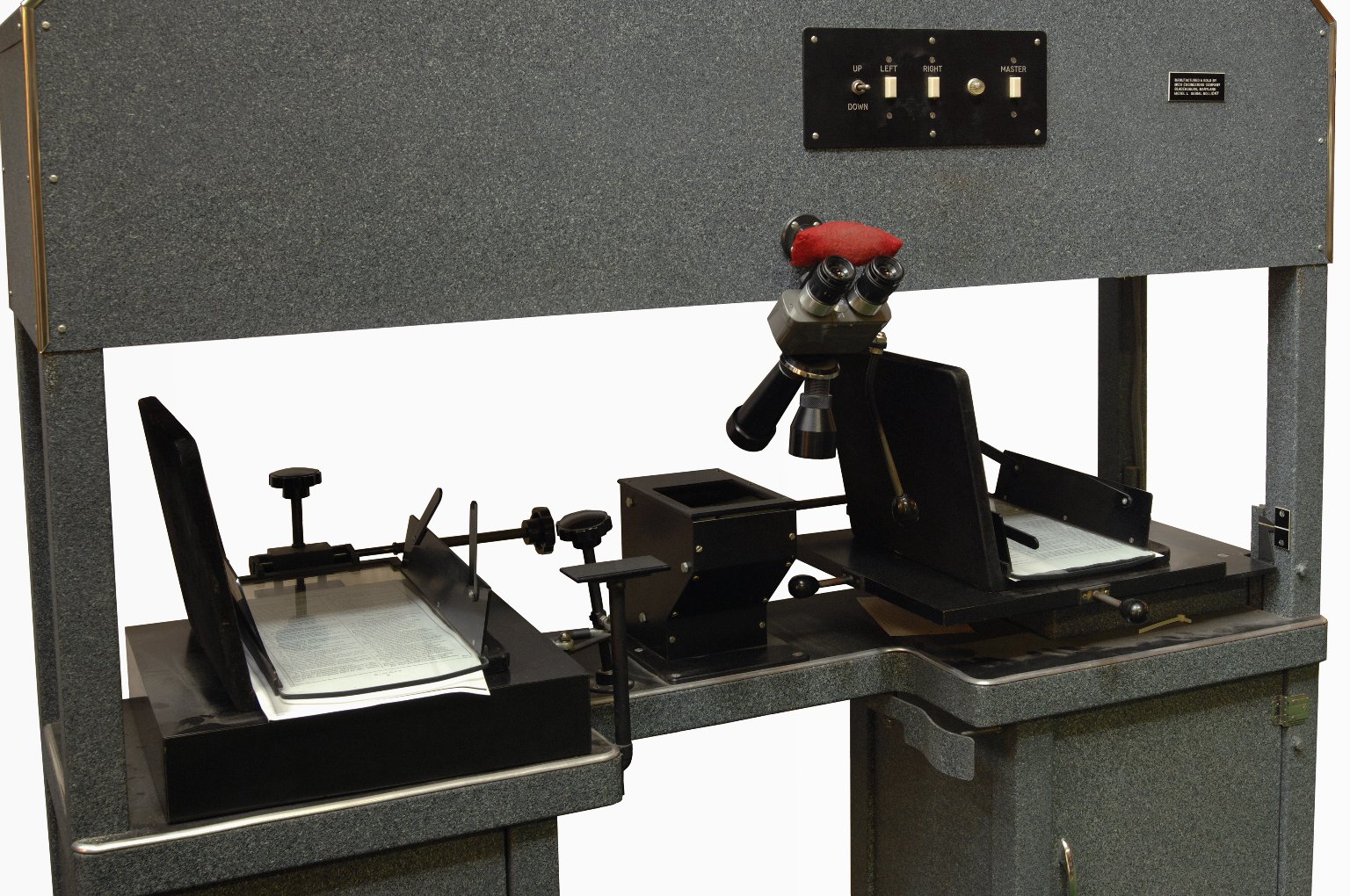Hinman collator on:
[Wikipedia]
[Google]
[Amazon]
 The Hinman collator, an early optical collator, was an opto-mechanical device for comparing pairs of documents for differences in the text. Documents that appeared similar were said to “collate”. The collator resulted in rapid advances in the study of literary works.
Invented by
The Hinman collator, an early optical collator, was an opto-mechanical device for comparing pairs of documents for differences in the text. Documents that appeared similar were said to “collate”. The collator resulted in rapid advances in the study of literary works.
Invented by
''Through the looking glass.''
Lingua franca, June 1997.
The Hinman Collator
, Stirling (Scotland): The Pathfoot Press, 2018.
Charlton Hinman and The Roots of Mechanical CollationInstructions for implementing Blink Comparator on personal computer
Optical devices Bibliography Textual scholarship
 The Hinman collator, an early optical collator, was an opto-mechanical device for comparing pairs of documents for differences in the text. Documents that appeared similar were said to “collate”. The collator resulted in rapid advances in the study of literary works.
Invented by
The Hinman collator, an early optical collator, was an opto-mechanical device for comparing pairs of documents for differences in the text. Documents that appeared similar were said to “collate”. The collator resulted in rapid advances in the study of literary works.
Invented by Charlton Hinman
Charlton Joseph Kadio Hinman (1911 in Fort Collins, CO – 16 March 1977 in Rockville, MD) was the editor of the ''Shakespeare Quarto Facsimiles'' and ''The Norton Facsimile: The First Folio of Shakespeare''. He is well known as the inventor of th ...
in the late 1940s, the device used lights and mirror
A mirror or looking glass is an object that reflects an image. Light that bounces off a mirror will show an image of whatever is in front of it, when focused through the lens of the eye or a camera. Mirrors reverse the direction of the im ...
s to superimpose images of the two documents so that differences in text alignment or wording stood out. This resulted in huge improvements in speed and efficiency compared to the traditional cross-referencing
The term cross-reference (abbreviation: xref) can refer to either:
* An instance within a document which refers to related information elsewhere in the same document. In both printed and online dictionaries cross-references are important because ...
of texts by eye.
The idea built on earlier work such as Carl Pulfrich's blink comparator used to help identify the former planet Pluto
Pluto (minor-planet designation: 134340 Pluto) is a dwarf planet in the Kuiper belt, a ring of bodies beyond the orbit of Neptune. It is the ninth-largest and tenth-most-massive known object to directly orbit the Sun. It is the largest ...
, and Hinman's work analysing aerial photographs during World War II
World War II or the Second World War, often abbreviated as WWII or WW2, was a world war that lasted from 1939 to 1945. It involved the vast majority of the world's countries—including all of the great powers—forming two opposing ...
.
Hinman used his device to compare the many slightly different impressions of the First Folio
''Mr. William Shakespeare's Comedies, Histories, & Tragedies'' is a collection of plays by William Shakespeare, commonly referred to by modern scholars as the First Folio, published in 1623, about seven years after Shakespeare's death. It is cons ...
of William Shakespeare
William Shakespeare ( 26 April 1564 – 23 April 1616) was an English playwright, poet and actor. He is widely regarded as the greatest writer in the English language and the world's pre-eminent dramatist. He is often called England's nation ...
's works. The printing
Printing is a process for mass reproducing text and images using a master form or template. The earliest non-paper products involving printing include cylinder seals and objects such as the Cyrus Cylinder and the Cylinders of Nabonidus. The ...
and bookbinding processes used in the time of Shakespeare often resulted in variations in the pages bound into the final books, and the collator enabled Hinman to describe the exact order in which the Folios had been composited and printed. He used the collator to compare 55 different copies of the First Folio held by the Folger Shakespeare Library
The Folger Shakespeare Library is an independent research library on Capitol Hill in Washington, D.C., United States. It has the world's largest collection of the printed works of William Shakespeare, and is a primary repository for rare materi ...
, and subsequently wrote about his findings in ''Printing and Proof-reading of the First Folio of Shakespeare'' in 1963.
In the wake of Hinman's success, the device was purchased by a number of universities, libraries and other institutions (allegedly including the CIA). As more compact types of collator were developed in the 1960s, the last Hinman was built in 1978. In his 2002 survey of mechanical collators, Steven Escar Smith estimates from scattered records that as many as 59 Hinman Collators were produced, 41 of these surviving at the time of his survey's publication.
A more portable collator was developed by Randall McLeod.Zalewski, Daniel''Through the looking glass.''
Lingua franca, June 1997.
See also
* Blink comparator * vdiffReferences
{{reflistExternal links
*Kelsey Jackson Williams,The Hinman Collator
, Stirling (Scotland): The Pathfoot Press, 2018.
Optical devices Bibliography Textual scholarship